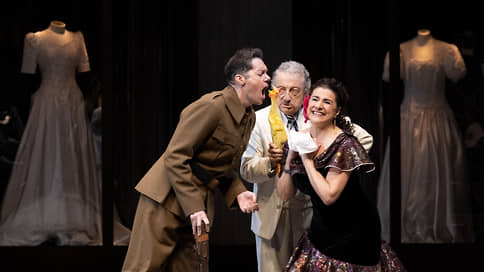Andalusian dance – Newspaper Kommersant No. 149 (7350) of 08/17/2022
[ad_1]

At the Salzburg Festival, Rossini’s The Barber of Seville was staged by the once-superstar tenor Rolando Villazon. Rosina (apparently for the last time in her career) was sung by Cecilia Bartoli, and the Les Musiciens du Prince orchestra was conducted by the faithful companion of the diva Gianluca Capuano. Tells Sergey Hodnev.
Rosina, the future Countess Almaviva, Cecilia Bartoli has been singing for a good thirty-five years. She staged her farewell to the role in an informal, but still inventive way: the production of The Barber, staged by Rolando Villazon, migrated to the summer Salzburg billboard from the program of Pfingstfestspiele, the Pentecost festival, which the prima donna has been directing since 2012. And in that program, Bartoli suggested remembering how much music – from the polyphony of the 16th century to Bizet, Albéniz and de Falla – is somehow connected with the image of Seville: here, they say, how not to remember the Barber of Seville, since the conversation about the Andalusian capital. But now, in the summer, Rossini’s masterpiece found itself in a completely different context: next to operas written in the 20th century, the performance was intended to play the role of a comic outlet, and at the same time add a completely different color to the opera program in terms of musical style.
The style is rather lucky: in the energetic, torrid sound of Les Musiciens du Prince there is a brilliant “historically informed” proficiency, there is a polished phrasing and dynamics, but still there is that irresistible Rossinian brio, without which no direction of The Barber can save. Yes, natural copper had blots, and a couple of times the desperately fast pace of the conductor’s vocalists made it difficult, but otherwise, Maestro Capuano’s interaction with the singers was quite healthy and organic. Naturally, Bartoli got the most care (as if even the Rossini orchestra, far from grandiosity, could not block a small voice), and yet, fortunately, absolutely greenhouse-museum precautions turned out to be superfluous. The “resigned and simple-hearted” heroine of the singer turned out to be much fresher and freer than, say, last year’s Handel at the same festival, and she laughed at the drummed coloratura, including in the literal sense: in the scene of a music lesson from the second act in a small impromptu with comical aplomb depicted a singing prima donna, skilfully and cleanly running through the registers.
Her Almaviva, the Uruguayan tenor Edgardo Rocha, sounded insipid in the first numbers, but sang in the second act – fortunately, in the finale, he was prepared for the standard vocal balancing act of the aria “Cessa di piu resistere”, which they did not stop. More obvious successes of the line-up are the powerful voluminous bass of Ildebrando d’Arcangelo (Basilio) and the skilful patter of the Rossini veteran Alessandro Corbelli (Bartolo), however, in the overall standings, Figaro Nicola Alaimo turned out to be the most stable, voluminous and colorful of all, who, in addition, was somehow more elegantly given dashing buffoonery . There is a lot of her in the performance, and even in the musical side she was answered by some quirks. With the light hand of Gianluca Capuano, who in Handel’s works strives here and there to use percussions that were completely not provided for by the score, castanets pounded generously in The Barber, and Lindor-Almaviva’s serenade (“Se il mio nome …”) completely turned into a sultry bolero. In addition, Andrea del Bianco, who played the continuo part on the hammerklavier, also broke away in recitatives – he would casually play something like the leitmotif of fire from the “Ring of the Nibelungs” at the moment when Rosina says that she was burned, then insert quotes from Joe Cocker’s song “You Can Leave Your Hat On” or Nino Rota’s soundtrack to “The Godfather”.
As for the production itself, it certainly bears the imprint of the clownish temperament of Villazón the artist – but this is not quite a blessing for her. At the behest of the director, the action of the opera takes place in a film studio from the Hollywood “golden age” with massive art deco scenery (the work of Harald B. Thor). There, under the supervision of the pompous producer-money bag La Forza (he and his relatives appear when law enforcement officers appear on the stage in the libretto), an eccentric projectionist vegetates, a character without speeches, played by the Italian comedian Arturo Brachetti. He stealthily watches the films of the local star Checha B. Artoli (the video parodies the famous roles of the real Bartoli), but something goes wrong with the film “Once Upon a Time in Seville”, its characters begin to move from the screen to the stage – “and everything is wrapped up” .
No psychology, no dramaturgic consistency, just an eye-catching series of gags, disguises, tricks and special effects. Basilio (since we are talking about movie antiquities) flaunts in the image of Nosferatu, the maid Berta sings her “sorbet” number, dressing up in a tailcoat and top hat under Marlene Dietrich, extras fall out in choral scenes, dressed as Roman legionnaires, who are Cossacks, and everyone fusses , and everyone dances, and even then, for the plans of some incomprehensible, Frankenstein’s monster rushes about restlessly. And in these flickering attempts, as if made with love, to make ridiculous such crampedness and closeness, which hardly anyone will impose on Rossini’s music from cold-blooded skeptical directors.
[ad_2]
Source link






